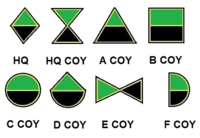Durban Light Infantry
| Durban Light Infantry | |
|---|---|

SANDF Durban Light Infantry emblem
|
|
| Active | May 1854 to present |
| Country | South Africa |
| Allegiance | |
| Branch | |
| Type | Infantry |
| Role | Motorised infantry |
| Size | One battalion |
| Part of |
South African Infantry Formation Army Conventional Reserve |
| Garrison/HQ | DLI Avenue, Durban 29°50′50″S 31°0′57″E / 29.84722°S 31.01583°ECoordinates: 29°50′50″S 31°0′57″E / 29.84722°S 31.01583°E |
| Motto(s) | Primus in Africa |
| Battle honours | |
| Commanders | |
| Current commander |
Lieut Col Z. Hangana |
| Honourary Colonel | Vacant Post |
| Insignia | |
| Company level Insignia |  |
| SA Mechanised Infantry beret bar circa 1992 |  |
The Durban Light Infantry is a Motorised Infantry regiment of the South African Army. It lost its status as a Mechanised infantry regiment in 2010 in line with the rationalisation of resources. As a reserve unit, it has a status roughly equivalent to that of a British Army Reserve or United States Army National Guard unit.
The Regiment was formed as the D’Urban Volunteer Guard, in May 1854. In 1859 it became the Durban Rifle Guard. In 1873 it became known as the Royal Durban Rifles. In 1889 it became known as the Natal Royal Rifles (Left half Battalion). In 1895 it became the Durban Light Infantry.
On the constitution of the Union Defence Force in 1912, the Unit became the Durban Light Infantry, renamed the 1st Infantry, (Durban Light Infantry). In consequence the Unit was permitted to add to its badge “Primus in Africa”.
In 1953, King George VI conferred the title Royal on two Regiments being the Royal Durban Light Infantry and the Royal Natal Carbineers, as a recognition of their seniority and service. In 1961 with the formation of the Republic, the title "Royal" was considered incompatible and the Regiment reverted to being the Durban Light Infantry.
At the centre of the 'Regimental Colour' is the badge worn by the Regiment since 1961. It consists of the recognised Infantry Silver Bugle with tassels and a shield with two wildebeest and a crown. The wildebeest are symbolic of the Province, while the crown retained as a traditional device is reminiscent of the title “Royal” bestowed upon the Regiment by King George V in 1935.
The words “Primus in Africa” are superimposed within a scroll.
The crest is composed of a lion passant guardant on three mounds – the centre mound being charged with a pyramid. The lion is symbolic of strength, courage and fortitude. The three mounds are symbolic of the battles fought in World War II – Monte Stanco, Monte Peza and Monte Sole/Caprara. The pyramid is symbolic of the 1941–1943 Egyptian Campaign.
...
Wikipedia
